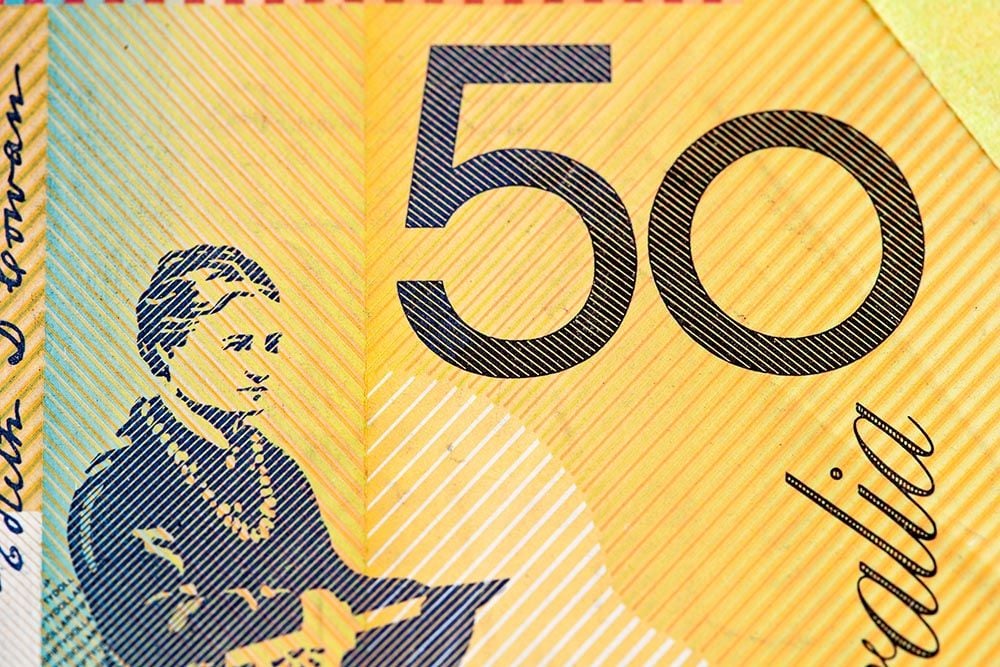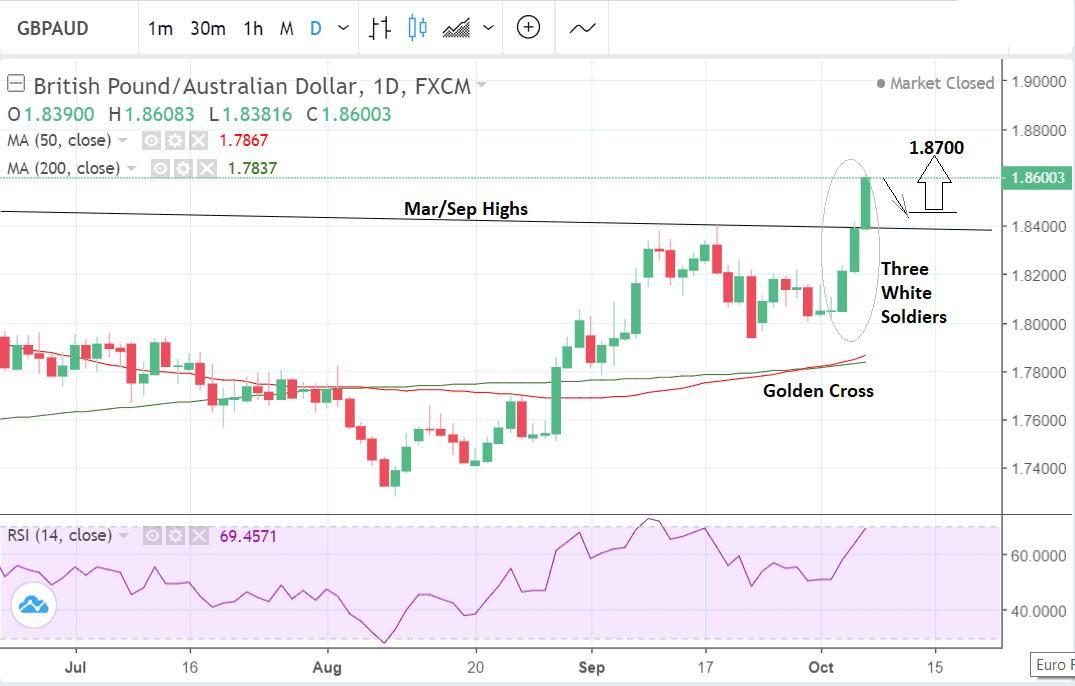5-Day Pound-to-Australian Dollar Rate Forecast: Uptrend in Order, but Growing Risk of Temporary Pull-Back

Image (C) Adobe Images
- GBP/AUD has broken above key ceiling
- Should ultimately extend rally
- China's cut to RRR over the weekend proves supportive to Aussie
The Australian Dollar starts the new week on a firm footing thanks to a weekend move by the People's Bank of China to cut the reserves commercial banks are expected to hold.
Reserve requirement ratios (RRRs) - currently 15.5% for large commercial lenders and 13.5% for smaller banks - would be cut by 100 basis points effective October 15, the PBOC said, matching a similar-sized move in April.
This should help stimulute the slowing Chinese economy which should in turn be supportive to the Aussie Dollar as China is Australia's largest export destination.
At the time of writing the GBP/AUD exchange rate is quoted 0.3% lower at 1.8554 which should offer some relief - at least temporarily - to the under-pressure Aussie Dollar.
The Pound rose against the Australian Dollar on every day of last week, from an opening exchange rate of 1.8037 to a close of 1.8600 - a rise of over 5 cents to the Pound over five days.
The gains came as a result of both a broad-based weakening of the Australian Dollar and a rise in the Pound which serves to establish a strong uptrend in the exchange rate that should ultimately extend.
The Aussie unit weakened after the Reserve Bank of Australia (RBA) stated they did not think they would be raising interest rates for the foreseeable future. The Pound, meanwhile, rose on heightened expectations Brussels and London were getting close to reaching a Brexit deal.
From a technical point of view, the pair broke through several major levels which suggest it may now be in an established uptrend. These included the 200-week moving average (MA) and a support and resistance level at the March/September highs.
The upside breakout above these levels on a closing basis is a game-changer for the pair and suggests a market bias to more gains in the future.
Other indications that the trend could be turning more bullish include the formation of a 'three white soldiers' Japanese candlestick pattern on the daily chart and the crossover of the 50-day MA above the 200-day MA, in what analysts call a 'golden cross'.
It is possible the pair will simply continue its uptrend next week, however, the RSI indicator in the bottom pane has reached 69 level which is just below overbought and this is a marginally bearish sign. If the indicator rises above 70 it will officially be in overbought territory and signal that traders should not open any new bullish bets.
We see a chance that these almost-overbought conditions could lead to a temporary pull-back, possibly as far back as the 1.8400 region before the exchange rate starts to rise again. We think it is unlikely the pair will break back below the March/September highs at 1.8400 now so this ought to supply a floor.
We recommend a limit order in this situation with an entry to buy at a slightly lower level than the current market level, probably starting at 1.8550 or 1.8500. Eventually, we expect the exchange rate to resume its strong uptrend, however and reach the next target at 1.8700.
Advertisement
Lock in Sterling's current levels ahead of potential declines: Get up to 5% more foreign exchange for international payments by using a specialist provider to get closer to the real market rate and avoid the gaping spreads charged by your bank when providing currency. Learn more here
The Australian Dollar: What to Watch this Week
The main releases for the Australian Dollar in the week ahead are probably various business and consumer sentiment gauges.
The Westpac consumer sentiment gauge is out at 00.30 on Wednesday and the NAB Business Confidence gauge at 1.30 on Tuesday, however, in truth these are probably not going to impact on the currency.
It is more likely the Chinese trade balance data out on Friday could have an impact instead.
The Australian Dollar is sensitive to any signs of a slowdown in the Chinese economy, so a fall in these key gauges could be negative for AUD.
Data has been relatively strong out of Australia recently, as exemplified by the retail sales figures out last week, but this has not been able to stem the currency's depreciation.
The main issue appears to be the fragile housing market and in relation to this next week's home loans data for August could be pertinent, as well as the financial stability report from the RBA also out on Friday (both at 1.30).
If home loans fall it will reinforce the negative perception of Australian housing and lessen still further the chances of the RBA raising rates. This, in turn, would weaken AUD.
The Pound: What to Watch this Week
All eyes now turn to a meeting of European leaders at a dinner on October 17 when they review the state of negotiations with the U.K. ahead of the October European Council summit.
"In October we expect maximum progress and results in the Brexit talks. Then we will decide whether conditions are there to call an extraordinary summit in November to finalise and formalise the deal," European Council President Donald Tusk said at the Salzburg informal summit.
Expect market nerves to remain piqued over the next week as headlines, rumours, optimism and disappointment create an unstable environment for traders to navigate.
"Brexit remains the key driver for the GBP and uncertainty related to the outcome is likely to keep the GBP volatile," says Mikael Olai Milhøj, a foreign exchange strategist with Danske Bank.
The president of the European Commission, Jean-Claude Juncker, has meanwhile said on the weekend he is sure a Brexit agreement could be reached in November, if not sooner.
Jean-Claude Juncker told three Austrian newspapers that Brexit without a deal "would not be good for the UK, as it is for the rest of the union".
He added:
"I assume that we will reach agreement on the terms of the withdrawal agreement.
"We also need to agree on a political statement that accompanies this withdrawal agreement - we are not that far yet.
"I have reason to think that the rapprochement potential between both sides has increased in recent days, but it can not be foreseen whether we will finish in October.
"If not, we'll do it in November."
At the moment there appears to be a lot of support for a Canada +++ arrangement even from within Theresa May's Conservative party, so if the proposal is broadly well received, it could be a big moment for negotiations and a concomitant rise in GBP.
Of course, the risk of a rejection is also quite high, and, therefore, a fall in GBP.
The question of the Irish border remains a sticking point but the UK has said it will propose a solution in the week ahead so there may be movement from news about that too.
On the data front, the main release is probably going to be GDP data, which is forecast to show a 0.1% rise in August, when it is released at 9.30 B.S.T on Wednesday. In July GDP rose 0.3%. A higher than expected result would help GBP.
"Things are looking rosier for the third quarter and there should be more evidence of this from the monthly GDP estimates due on Wednesday. UK GDP is expected to have expanded by 0.1% m/m in August, to produce an annual figure of 1.5%," says a preview from FX broker XM.com. "On a 3-month basis, growth is forecast at 0.6%, which would match July’s rate and point to growth of a similar amount for the third quarter."
Another major release for the Pound is likely to be the trade balance in August, which is expected to show a -10.9bn deficit when it is released at the same time on Wednesday.
Industrial and manufacturing production are also out at the same time and are both forecast to show a 0.1% in August compared to the previous month.
Finally, the Royal Institute of Chartered Surveyors (RICS) house price balance is out just after midnight on Thursday morning and the retails sales monitor for September is released by the Consortium of British Industry (CBI) just after midnight on Tuesday morning.
Advertisement
Lock in Sterling's current levels ahead of potential declines: Get up to 5% more foreign exchange for international payments by using a specialist provider to get closer to the real market rate and avoid the gaping spreads charged by your bank when providing currency. Learn more here





